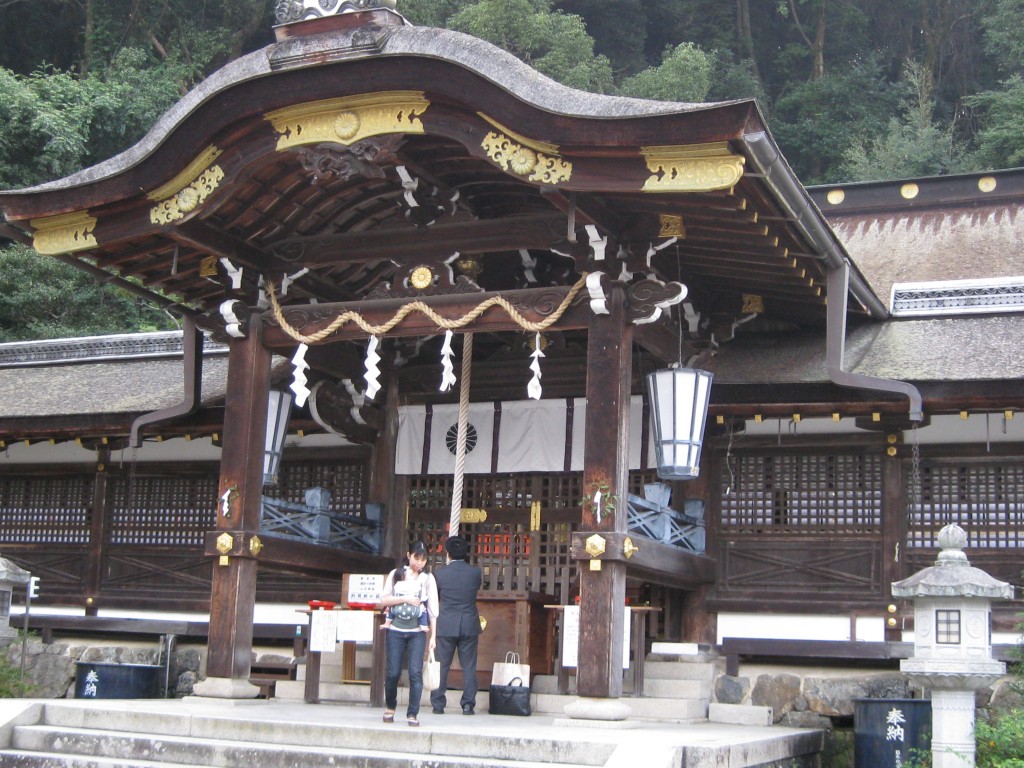
1) Origins
Kyoto’s oldest shrine? It’s been battling that out with Kamigamo Jinja for some time now.
The Matsuo area was a stronghold of the Hata clan, the Kamigamo area that of the Kamo. The two clans were settled in the Kyoto basin by the fifth century, with the Hata worshipping their tutelary kami on Mt Matsuo and the Kamo on Mt Koyama. One of the kami descended into a sacred rock, the other a sacred tree. With the arrival of Buddhism in the sixth century, the idea of housing deities spread through Japan. Could not kami be honoured in similar manner? Shrine buildings were put up, and Matsuo Taisha was founded at the foot of Mt Matsuo in 701.
The Hata are said to have immigrated from Korea around the turn of the fourth and fifth centuries. With them they brought all kinds of continental skills, including silk-weaving and large-scale earth moving, such as irrigation works. In this way they amassed wealth and prestige, and they were instrumental in Kammu’s choice of Kyoto as his new capital in 794 for they not only provided him with the land but the expertise in laying out the terrain and redirecting the rivers.
The ancient water courses that cross the shrine bear testimony to the skills of the Hata. They’re a fascinating clan, and I feel strangely drawn to them. They were not only responsible for setting up Matsuo, but Fushimi Inari (711) and the Buddhist temple of Koryuji (622). There’s fanciful speculation on the internet about them being of middle eastern origins, even Jewish, and of bringing Nestorian Christianity to Japan. Be that as it may, they were instrumental in shaping Kyoto and I hope to do a special on them soon when I go to visit their small Kaiko no Yashiro (Silkworm Shrine) in west Kyoto.
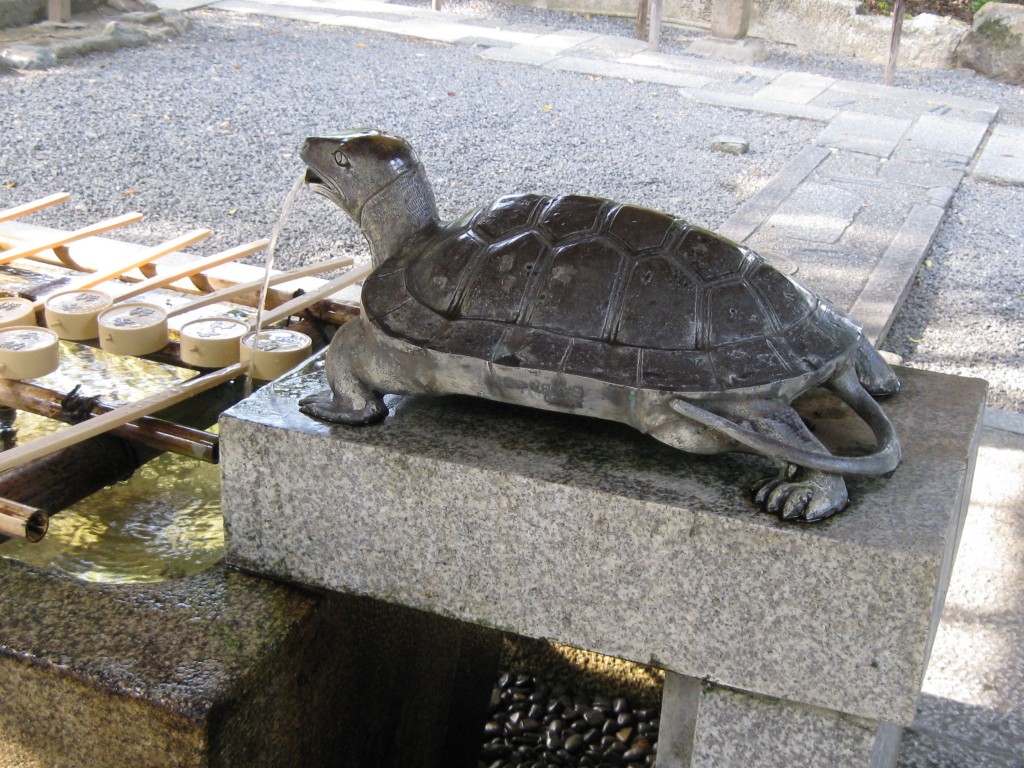
The water basin at Matsuo
2) Turtles and saké
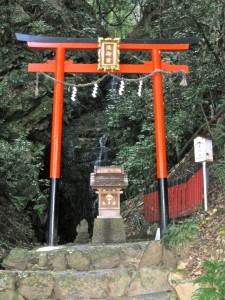
Waterfall of the sacred turtle
Matsuo is full of turtles. Why? It’s said the shrine’s founder, Hata no Imikitori, was walking round the grounds one day when he came upon a turtle basking at a waterfall. He took it as a good omen, for turtles symbolise longevity, and he named the nearby well as ‘kame no i‘ (tortoise well). Its water is said to prolong life and stop saké from souring. Now there are turtles at every water basin. There’s a small Waterfall of the Sacred Turtle behind the shrine, too.
Apart from turtles, Matsuo is noted for saké. What do turtles and saké have in common? Yes, water. The quality of the crystal-clear water trickling down from the sacred mount behind the shrine was conducive to saké making, and the shrine developed a reputation in similar manner to the way that medieval monasteries were known for the beer they brewed. Now saké companies patronise the shrine, and there’s a saké festival every year on the October national holiday.
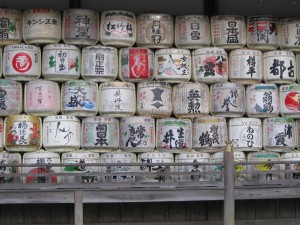
Offerings of saké
The shrine capitalises on the saké theme witih
a special fortune telling method which is fun. You fire off your arrow at empty saké barrels and where you hit determines what you receive. Games like this are often found at shrines, a degeneration of ancient fortune-telling techniques used in shamanism when knowing the future was deadly serious.
The ema (votive tablets) are in the shape of rice paddles (shamoji), used in the brewing process. Ema started off with a horse motif, since horses were intermediaries with the spirit world. Here the horse picture has been transformed into a different medium of contacting the ‘spirit world’!
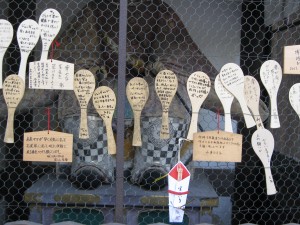
Rice paddles (used in saké brewing)
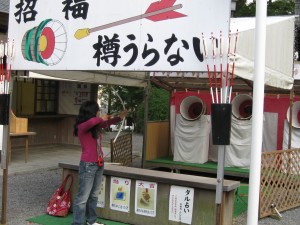
Firing off a fortune-telling arrow
3) Physical kami
Kami are without form or substance. That’s what makes them pure pureness. Yet Matsuo has three wooden representations of its kami. How come? Again it’s all about the influence of Buddhism. Seeing the glorious artwork involved in representations of Buddhist deities made Shintoists wonder if they could not do the same.
The Matsuo statues date from the tenth century and are amongst the oldest of their kind. They are presumed to represent the two original kami (the male Oyamagui and the female Nakatsushimahime), plus a third that was added later and enshrined separately, Tsukuyomi. The latter, a personification of the moon, is the brother of Amaterasu. I guess he could even be considered a twin since in mythology he appeared out of one eye of Izanagi while the sun goddess appeared out of the other. Two celestial eyes, I guess you could say, which mirror each other.
The sun goddess went on to radiant glory, but the moon deity – how shall I put it? – was plunged into relative darkness. Given the Japanese cult of the moon (haiku, symbol of enlightenment, moon-viewing parties,
Tanizaki’s praise of darkness and ‘Shadows’), it’s perplexing how rarely Tsukuyomi is honoured at Shinto shrines. How intriguing! The only explanation I’ve come across is that while Amaterasu was adopted as tutleary kami by the ruling Yamato clan, Tsukuyomi was patronised by a clan which passed into obscurity. So why would the Hata have added him to their pantheon? Mmm… something I’ll have to go back and ask the priests about…
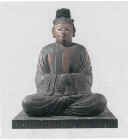
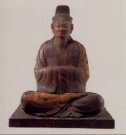
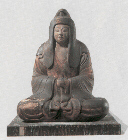

Paul Carty has written in with the following:
Matsuo Taisha is a magical place indeed and very closely connected to the north and south Kamo shrines, Hiyoshi Shrine, and Fushimi Inari. According to your post some type of Shinto rituals have been practiced there since the 4th century. Why did it take so long to erect shrine buildings? One can assume that at Ise and Izumo structures were there around the 4 or 5th century or earlier. Is it because this might have been a different type of Shinto a more tutelary type of practice in that it was only their family god being worshipped? Or might it just be that they were just not major enough at that time, so not enough resources? Although the latter makes no sense as these families were very powerful.
Hi Paul…
I’d like to say thanks for the question, though it’s very vexing as I don’t know the answer. Ise and Izumo may have been exceptions to the general rule of outdoor worship and temporary structures. I haven’t yet found a firm date for when their ‘permanent’ shrine buildings were first established. Also it’s impossible to know what the Hata may have been thinking during the sixth and seventh centuries. Maybe they simply followed the way of their forefathers in worship. What was good enough for granddad was good enough for them… maybe, like me, they found climbing up Mt Matsuo to worship at the sacred rock more spiritually fulfilling than having a shrine at the bottom. You could, after all, see it as a symptom of decadence and ‘modern’ decay…
Hi John
Nice blog
according to Como in “Weaving and Binding” the Hata were responsible for kamo………